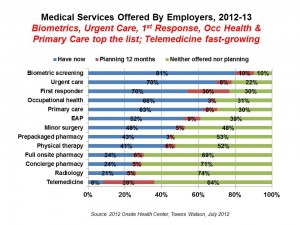 With “Zero” large employers expecting to drop health insurance, as reported in the Washington Post, companies are getting creative and innovative about how to manage workers’ health and wellness, while addressing ever-growing costs. One strategy that’s getting more traction is the re-invention of the onsite health center.
With “Zero” large employers expecting to drop health insurance, as reported in the Washington Post, companies are getting creative and innovative about how to manage workers’ health and wellness, while addressing ever-growing costs. One strategy that’s getting more traction is the re-invention of the onsite health center.
Towers Watson‘s 2012 Onsite Health Center survey report, finds that one-half of employers view establishing an onsite health center as a linchpin to enhancing productivity and health in the workplace. Following close behind productivity is the onsite health center’s promise of reducing medical costs, improving access to care, and the traditional reason for providing onsite care: serving occupation health and safety needs.
Lifting the hood of worker health programs, Towers found that biometric screening, urgent care, first responder services, occ health, primary care, and EAP counseling are currently offered by over 50% of employers. These are shown in the chart.
But the most significant growth in employer-sponsored health programs will be telemedicine, cited by 28% of employers as a program that will be offered within 12 months. Telemedicine is now used by employers on a stand-alone basis as well as complementing onsite services, by 8% of companies. Telemedicine is seen as productivity-enhancing for the workforce as using it can reducing time in doctors’ offices and getting appointments, reducing time away from work, and time lost at work in scheduling appointments and worrying about a condition before getting to see a clinician.
Health Populi’s Hot Points: Towers points out that employers will be “going beyond traditional medical services.” That means getting beyond traditional occ health, lumps, bumps and bruises care. Companies are already on the road toward providing more primary care, especially looking at disease and chronic condition management (currently offered by 48%, with another 17% of companies planning it for 2013), care coordination and case management (at 41% today, with another 21% planning to offer in 2013). This is real population health management.
Switched-on employers finally realize that bending their health cost curves requires getting a stronger and more accessible primary care infrastructure in place. Siting a health center on-campus helps the access issue, and getting closer to patient-employees where they live and work bolsters good timing and location to capture workers either before they develop chronic conditions, or serve the conditions sooner before they escalate and generate greater downstream costs and lower productivity.
With employers saying they’re staying in the game of providing health insurance to employees and (most) dependents, siting health centers onsite makes great sense.




 Thank you, Jared Johnson, for including me on the list of the
Thank you, Jared Johnson, for including me on the list of the  I am so grateful to Tom Lawry for asking me to pen the foreword for his book, Health Care Nation,
I am so grateful to Tom Lawry for asking me to pen the foreword for his book, Health Care Nation,  Thanks to Feedspot for naming this blog, Health Populi, as a
Thanks to Feedspot for naming this blog, Health Populi, as a